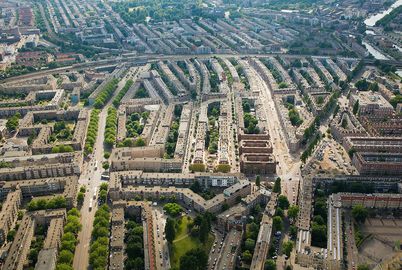

The history of the Indischebuurt began in the 13th century with the construction of the St Anthonis dike, which is now called Zeeburgerdijk and which runs from Amsterdam to Diemen to this day. Needless to say, in the 17th and 18th centuries the dike offered a very different panorama than it does now. To the south was a typical polder: orchards, farms, pastures with cows and drainage ditches. To the north were the large swampy areas partly overgrown with reeds and known among the locals as Rietlanden, an area which was regularly flooded by the sea. As a result, a second dike was erected in 1401 - the Kadijk - approximately there where now Piet Hein Tunnel is located in order to protect the countryside north of the St Anthonis dike. The Kadijk was a low summer dike which only prevented the floods at low tides. Thus not only the Zuiderzee and the IJ, but also the water mass of the drained Diemer-Watergraafsmeer inlet were a constant and serious threat. The draining and reclamation of the Watergraafsmeer in 1629, now the site of a posh neighborhood as well as the Science Park north of the Indische Buurt, was a great improvement, but still there were dike breaches, such as a famous one in 1651, which resulted in great damage as well as claimed lives.
The reeds from the Rietlanden were often used for the thatched roofing of the farms. This district often sheltered smugglers who tried to bypass the Muiderpoort customs house and get goods into the city without paying the excise tax. In the 18th century, when Amsterdam began to expand eastward, the windmills, the industry and the ports were moved to or built around here.
Early 1900s witnessed the birth of the Indischebuurt, which was built in two parts. The oldest part is now northeast of the Javastraat; the Atjehstraat ran along the meadows at the time. Makassarplein actually originally built as a velodrome, where in 1901 the first bicycle race in the city was held.
During the First World War, although the Netherlands was neutral, the neighborhood was faced with increasing poverty, bread riots and even hosted an attempt at a socialist revolution. In 1918, bakeries on Celebesstraat, Java Street and Javaplein were looted and it took police on horseback and armed with sabers to restore order.
The second phase of the Indischebuurt construction began around 1924, when the houses were built around Ambonplein, the Makassarplein and the Sumatraplantsoen. In 1926 the Majella Church was consecrated and the construction of the Zuiderzeepark (currently named Flevopark) had commenced.
Between the wars, the composition of the neighborhood remained diverse. Both public and Christian schools were built. The neighborhood was home to socialists, communists, Reformed Dutch, Roman Catholics, Lutherans and the Jews and each community founded its own churches, schools, private associations, initiatives, clubs and cultural venues.
In the late 1930s and during the war, the neighborhood fell into decline. Riots, demolitions, the occupation, looting and deportations took their toll. However, after World War II there was a new explosion of different communities. The Communists gained authority thanks to their leading role in the resistance against the Nazis. In 1946, they received 43% of the votes in the Indischebuurt, while the average in the entire city was about 30%. The stronghold of the Communists was on the Minahassastraat, where residents were even able to take a course on Stalinism.
In the 1960s and through the 1980s, as many old residents and families were moving to new and growing suburban towns such as Diemen, Purmerend and Almere, vacant homes became squatted and the sex industry and drugs, heroin in particular, were rampant. Ensuing gentrification in the following decades accounted for shifting demographics. New immigrants, in particular the Turkish and the Moroccans, now represent the majority of the population; a Moroccan and a Turkish mosque are erected, while the Protestants and the Catholics revert to smaller accommodations.
Up until recently, the Indischebuurt continued to have something of a bad reputation. The police have had to deal with prostitution, violent robberies, petty as well as organized crime and a generally uncooperative and recalcitrant population. However, after 2003 the municipality made it a point to start with renewal and construction, attempting to make the composition of the neighborhood more socio-economically diverse. Since then, the Indischebuurt has been transformed from something of a backwater into a national and, perhaps, even international example of urban development. There was considerable investment in public improvement, including the redesigned squares and renovated buildings.